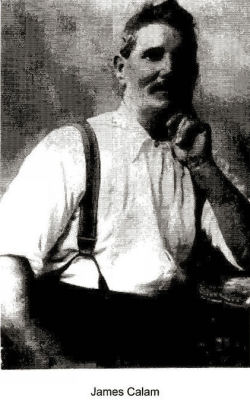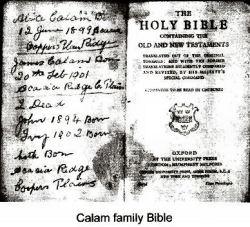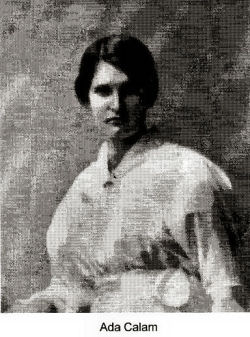James Calam
was born in the village of Rillington in the eastern
part of Yorkshire. At the time of the 1881 English
census he was living with his parents in the ‘Rillington
Low Moor Farm House’ which was situated on a 43-acre
farm. The members of the household and their ages are
listed in the census records as follows: William Calam
(58, head), Rachel Calam (57, wife), Arabell Calam (22,
daughter), James Calam (20, son), Alice Calam (18,
daughter), Ada Calam (14, daughter), Winter [sic] Calam
(9 months, grandson).

Taking account of the ages of the parents, one might ask
whether other children may have died or grown up and
moved out of the family home. A glance at earlier
censuses will show that this is the case. Christiana
(then aged 10) and Frank (9) are included in the 1861
census, and John (4) in the 1871 census. There is also a
reference in IGI to an Agnes Calam, daughter of
William and Rachel Calam, who was christened in
Rillington, Yorkshire, on 3 June 1855.

From these records we learn that William Calam was a
cordwainer or shoemaker, an occupation that he was still
involved in as late as 1910 when, having moved a few
miles from the old family home, he and Rachel were
living in the village of Thornton Le Clay in Yorkshire.
James Calam married Elizabeth Belt (b. Yedingham,
Yorkshire, 8 July 1861; bap. 22 September 1861), the
daughter of John (a farmer) and Rebecca (née Oliver)
Belt, in the September quarter of 1881. While still in
England they became the parents of George (b. 28
December 1881) and Arthur (b. 11 April 1884). Elizabeth
was pregnant with her third child when she and James and
the two boys set out for Australia on the BISN Company’s
2,500-ton Bulimba (Captain GD Clarke). Also
listed as travelling with them as their child is Herbert
(aged 6) who, according to a Calam descendant, was the
son of Arabell (or Arabella) Redshaw, James’s sister.
The shipping records indicate that both James and
Elizabeth were literate, that they were Protestants and
that the family travelled as free passengers. James
Calam was one of four men who had gone from Rillington
to Hunmanby, another North Yorkshire village, early in
January 1887 to confer with the Queensland Government
envoy, George Randall, whose task it was to ‘sell’
Queensland to prospective emigrants as a very prosperous
agricultural state.
The Bulimba left the Royal Albert Docks, London,
on 25 January 1887 and Gravesend on the next day with
464 immigrants on board, 298 of them destined for
Brisbane. It travelled through the Suez Canal to Batavia
and Queensland’s northern ports before anchoring early
on 24 March 1887 in the Brisbane Roadstead whence it was
escorted up the river by the Boko on the forenoon
tide.
As will be indicated below, the Calams were connected to
the Yorkshire Redshaws by marriage. It is interesting to
note, therefore that a Redshaw family from Yorkshire was
also on this voyage of the Bulimba—Aaron (30),
Harriet (33), Frances (8), Richard (5), Ethel (3) and
Emily (1). They travelled as free passengers and
disembarked in Maryborough.
The following (unedited) letter was written by Jim Calam
to his farmer master in England who kindly sent it to be
read at the Queensland meeting in Newton-on-Rawcliffe on
October 5th. The sister to whom reference is
made in the last sentence may be Arabell who with her
husband George Redshaw and their children resided at
Newton-on-Rawcliffe before they set out for Queensland
as free passengers on the 1145-ton Eastminster
(Captain Rees) which left Plymouth on October 29th
1887.
Goodna, near Brisbane, Queensland, May 3rd
1887
Dear Friends,
I promised to write to you. We landed all safe and
sound, and we thank God for a good voyage. We reached
Brisbane in 8 weeks and 2 days in the good steamship
“Bulimba”. I got work the day after we landed to go to
Peter Noble’s. I was engaged at 15/- a week, and 10 lbs
of beef, 2 lbs sugar, 10 lbs of flour, ¼ lb of tea, the
use of a cow and half a dozen hens and wood to burn, and
as many vegetables as we can eat, and I think that not
bad for a start in the new and happy land. I is in a
little place by ourselves, about 2 miles from the
village and 4 miles from Nobles and I have it about to
myself to work. It is only 17 acres of all and one part
swath, so I is not killed with work. It is on the river
side and the railway on the other. It is a fine place to
live and very fine country to live in. There is plenty
of jobs at 6/- day and 8/- but they aren’t any good.
They are hard to work. I think to settle down is the
best at a regular thing and have easy work. Farming here
ain’t like farming at home. It is more like gardening.
You might perhaps like to know if it is right that they
can get 2 crops or not. They can get 3 crops of one
piece of land if they look after them and get them sown.
You know yourself if they are not put in they won’t come
up. Indian corn is from 8 to 12 weeks from sowing to
being fit for market, and they can grow potatoes in
between the rows, as they are two foot wide. We never do
anything but plough and plant. There is no working land
here, no summer fallow, no wicks, no muck plugging. I
start work at 7 in the morning and leave at 5 at night
and work as hard as I like and as easy. It is coming on
winter now, and it is as warm as you would have it in
June. We have just got out hay led, and I is ploughing
the ground to sow with clover. They call it lucerne
here. It is fit for cutting every month, and it is £8 a
ton when it is chopped up. Horses and cattle is cheap. I
can buy a cow for £3 as good as any you have on your
place, and good beef at 3d a lb as you will give 10/- a
stone for at home, and a good horse for £10 as any man
would want to put a collar on. There is plenty of grass
and straw that make cattle cheap. There is thousands of
acres not fenced in that one can turn there cattle out
in. It is government land. There is thousands of acres
of land that whither man has not put foot on as yet. The
trees about here are very high from 80 to 100 feet and
very clean in the hole [bole?], and will split very
straight and regular, so that people can build there
houses with them. They are all wood houses here, and if
you were to see them, you would think them were very
queer to what you see in England. People are not as fine
and proud as they are at home. They seem to get some
land of there own, and build their own houses, and they
havent the land lord coming on their door steps for the
rent, and that is what I mean to be before long. I is
not afraid that I can make a better living here than in
England. I think that there is a lot of weak headed
people that is standing at Rillington Corner hungering
and starving and will die before they leave the country
to come in a new and happy land. I think there is a lot
that has a good chance as me to get here and can land
with as much money as I did, for I only had 7½d when I
left London. I bought a gun and it took all but that. I
thought I would be a man or a mouse. You would think you
would want a good heart in your belt [belly?] to start a
journey of 15,000 miles with 7d in your pocket and a
wife and 2 children at your heels, and I sent you a
letter cost 6d landed like a man with 1½d in my hands. I
would rather land here with a 1d and stay than with £5
in my pocket. I have a £ now and no one wants it here,
and that is more than I would have in England in 5
years, and I mean I have £100 before long if I have good
health and strength, and that is if God will allow me to
have it. George likes his place well, says the country
is far before low-marr [?], up to knees in clay. Tell my
sister we are alright and happy.
Eight more children were added to George (pictured) and
Arthur in Australia: Rebecca (b. 20 July 1887; m.
William Thomas Hedley 19 February 1908), Kate (b. 3
February 1890; m. Frederick Jeffery 22 June 1911), Frank
(b. 9 June 1892; m. Pearl Irene Spencer 6 October 1917;
d. 4 April 1954), John (b. 22 October 1894; d. 5 April
1895), Ada (b. 25 January 1896; m. Julius Richter 29
July 1916; cremated 16 June 1977), Alice (b. 3 July
1899; m. James William Varney 11 October 1919), James Jr
(b. 20 February 1901; m. Kate Emily Dawes 10 November
1923), Ivy (b. 24 February 1902; d. 30 July 1902). For
the record, the details of the two children born in
England are as follows: George (b. 28 December 1881; m.
Elizabeth Palmer Compton 16 December 1908), and Arthur
(b. 11 April 1884; m. Ellen Compton 3 April 1915).

Ivy Calam,
the youngest of these children, was the first member of
the family to be interred in God’s Acre. Two days after
her death on 30 July 1902 at the age of five months her
funeral service was conducted by the Reverend B Peterson
of the Lutheran Church. Elijah Beckett certified the
burial which was officially witnessed by W Edwards and
George Boyland. Ivy was the second of the Calam children
to die in infancy, John Calam having passed away at
‘Park Ridges’ near Waterford on 5 April 1895 before the
family moved to Acacia Ridge. John’s remains were laid
to rest on 7 April 1895 in the Chambers Flat Cemetery.
William Scott conducted the service at the burial which
was certified by John Story and officially witnessed by
Charles Howin.
|